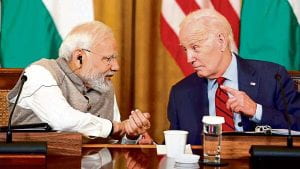Policy Commentary, May 2 2024
Dr Satu Limaye

Introduction
The complex network of diplomatic relationships between states becomes more evident in the constantly evolving geopolitical landscape. Within this framework, the alliance between the United States and India emerges as a very promising one. Throughout the last seven decades, these two nations have traversed a complex trajectory characterized by divergent interests and objectives. Yet, the current century offers a unique chance for a robust collaboration between the United States and India, as their strategic objectives converge in light of China’s changing global influence. The geopolitical landscape is now seeing a shift away from the clear-cut rivals of the Cold War era, and instead, we are witnessing continuous and complex rivalry in regions such as Gaza, Ukraine, and the Indo-Pacific. At this critical juncture, the United States and India are in a situation where their interests are increasingly aligned, requiring a reassessment and adjustment of their diplomatic relations.
Opportunities
Amidst challenges to its leadership and dominance, both inside the country and on the global stage, the United States is striving to form alliances and collaborate with partners that go beyond traditional power dynamics. India has a special chance to engage in more sophisticated cooperation, characterized by seeking agreements gradually and to a limited extent, rather than in absolute terms. The fragmentation of the international rules-based system underscores the need for adaptable and interconnected coalitions, supplanting traditional one-on-one models with a more intricate network of alliances.

India, due to its strategic location, presents itself as a promising partner for the United States, not only in the Indo-Pacific region but also in areas like as supply chain collaboration, access to crucial minerals, and cooperation within the Quad relationship. The emergence of targeted industrial and innovation partnerships, together with the shift towards competitive government support and domestic industrial strategies, provide fresh opportunities for collaboration. The expansion and interconnection of geographical areas, especially in the Indo-Pacific region, provide additional levels of intricacy to diplomatic relationships. The increasing impact of the transatlantic community necessitates a more all-encompassing strategy towards diplomacy. With the growing interconnectedness of the world, both countries have the opportunity to use these connections for their shared benefit.
Challenges
While there is a positive outlook on possible cooperation, it is crucial to exercise prudence. The United States and India vary fundamentally in their structural components and strategic ambitions. The complex political landscapes in both countries, together with numerous challenges in Europe, the Middle East, and the Indo-Pacific region, need a careful and skillful balancing of interests. India’s commitment to autonomy and multipolarity directly contradicts the United States’ desire of primacy. Proficient diplomacy becomes essential to bridge the disparity between these conflicting goals for worldwide governance. There may still be obstacles in the form of financial, administrative, bureaucratic, and procedural challenges that might impede the progress of collaboration and development. Moreover, while the mutual interest in the Indo-Pacific strategy, it is imperative to acknowledge and resolve the divergent objectives between the United States and India. Due to its alliance responsibilities, the United States may give more priority to some matters in East Asia compared to India. To effectively manage these opposing agendas, it is necessary to establish strategic alignment and maintain continuous communication to uphold a cohesive strategy across the area.
Way Forward
Notwithstanding these difficulties, the strategic alignment between the United States and India remains robust and promising. The basis of this developing partnership is on the reciprocal assessment of security concerns, cooperation in industry and defense, and strategic coordination in combating terrorism. The shared areas of agreement serve as the foundation for creating strategies and tools that may enhance the relationship between the two countries. It is crucial to have the ability to collaborate with other countries, build alliances, coordinate plans for the Indo-Pacific area, use multilateralism to put strategic convergence into action, and prioritize cooperation in military relations and diplomatic tactics. When used proficiently, these instruments may successfully address present challenges and facilitate a stronger and more dynamic alliance between the United States and India on the international platform.
Remarks made by: Dr Satu Limaye, Vice-President, East-West Center & Director, East-West Center, Washington at First Virtual Panel Discussion on ‘The US-India Political/Strategic Landscape and Its Impact,’ January 18, 2024, as part of an ongoing project
on Partners in Progress: How Does the US-India Strategic Partnership Matter?
Organized by: Centre for East Asian Studies, CHRIST (Deemed to be University) & Rising Powers Initiative, Elliott School of International Affairs, George Washington University in collaboration with US Consulate General, Chennai.
